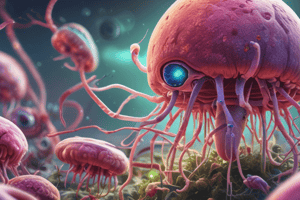Podcast
Questions and Answers
A parasite that can survive in a host as well as independently in the environment is classified as which of the following?
A parasite that can survive in a host as well as independently in the environment is classified as which of the following?
- Specific parasite
- Facultative parasite (correct)
- Temporary parasite
- Obligatory parasite
Which type of parasite establishes a long-term infection in a host and does not leave?
Which type of parasite establishes a long-term infection in a host and does not leave?
- Permanent parasite (correct)
- Specific parasite
- Accidental parasite
- Temporary parasite
Which type of parasite is exemplified by a mosquito that feeds on a host and then leaves?
Which type of parasite is exemplified by a mosquito that feeds on a host and then leaves?
- Temporary parasite (correct)
- Specific parasite
- Ectoparasite
- Endoparasite
A human ingests fly larvae by accident, leading to a parasitic infection in the intestine. How would these parasites be classified?
A human ingests fly larvae by accident, leading to a parasitic infection in the intestine. How would these parasites be classified?
Analyzing a stool sample, a lab technician identifies parasite eggs that originated from ingested animal liver that was infected, but the patient is not infected. How should these parasites be classified?
Analyzing a stool sample, a lab technician identifies parasite eggs that originated from ingested animal liver that was infected, but the patient is not infected. How should these parasites be classified?
Which characteristic defines mutualism, as opposed to other symbiotic relationships?
Which characteristic defines mutualism, as opposed to other symbiotic relationships?
How does phoresis differ from other symbiotic relationships, like mutualism or commensalism?
How does phoresis differ from other symbiotic relationships, like mutualism or commensalism?
Why is it important to avoid sharing personal items such as towels and bed sheets with an infected person?
Why is it important to avoid sharing personal items such as towels and bed sheets with an infected person?
What is the primary risk associated with consuming raw or undercooked fish, according to the content?
What is the primary risk associated with consuming raw or undercooked fish, according to the content?
How do houseflies contribute to the spread of parasitic infections?
How do houseflies contribute to the spread of parasitic infections?
What is the most likely route of transmission for Toxoplasma gondii?
What is the most likely route of transmission for Toxoplasma gondii?
If a parasite produces enzymes that cause lysis of tissue in its habitat, what type of damage is it causing?
If a parasite produces enzymes that cause lysis of tissue in its habitat, what type of damage is it causing?
What pathological process is exemplified when Ascaris lumbricoides causes intestinal obstruction?
What pathological process is exemplified when Ascaris lumbricoides causes intestinal obstruction?
Which of the following best describes the distinction between an obligatory parasite and a facultative parasite?
Which of the following best describes the distinction between an obligatory parasite and a facultative parasite?
In the context of parasitology, what differentiates a temporary parasite from a permanent parasite?
In the context of parasitology, what differentiates a temporary parasite from a permanent parasite?
What is the primary difference between a definitive host and an intermediate host in a parasite's life cycle?
What is the primary difference between a definitive host and an intermediate host in a parasite's life cycle?
A paratenic host plays what specific role in a parasite's life cycle?
A paratenic host plays what specific role in a parasite's life cycle?
Why is a 'dead-end host' significant in the context of parasite transmission?
Why is a 'dead-end host' significant in the context of parasite transmission?
How does a reservoir host contribute to the persistence of parasitic infections in a population?
How does a reservoir host contribute to the persistence of parasitic infections in a population?
In parasitology, what is the key characteristic of a vector?
In parasitology, what is the key characteristic of a vector?
What distinguishes parasitism from commensalism?
What distinguishes parasitism from commensalism?
An endoparasite capable of completing its life cycle without a host is classified as which of the following types of parasites?
An endoparasite capable of completing its life cycle without a host is classified as which of the following types of parasites?
If a parasite is described as 'specific,' which aspect of its host interaction is being emphasized?
If a parasite is described as 'specific,' which aspect of its host interaction is being emphasized?
A biologist discovers a new parasite that briefly visits its host solely for feeding purposes. How should this parasite be classified?
A biologist discovers a new parasite that briefly visits its host solely for feeding purposes. How should this parasite be classified?
A researcher identifies a parasite in a fecal sample that originated from contaminated food the host ingested, but the host remains uninfected. How is this parasite best classified?
A researcher identifies a parasite in a fecal sample that originated from contaminated food the host ingested, but the host remains uninfected. How is this parasite best classified?
A previously free-living organism mistakenly enters a host's body and begins to cause parasitic infection. Which of the following classifications is most accurate for this organism?
A previously free-living organism mistakenly enters a host's body and begins to cause parasitic infection. Which of the following classifications is most accurate for this organism?
In a parasitic relationship, if the parasite benefits by obtaining nutrition and protection while causing harm to the host, how is this interaction best characterized?
In a parasitic relationship, if the parasite benefits by obtaining nutrition and protection while causing harm to the host, how is this interaction best characterized?
If a parasite is described as 'specific,' what does this imply regarding its host preference or life cycle?
If a parasite is described as 'specific,' what does this imply regarding its host preference or life cycle?
How would you classify a parasite detected in a stool sample that originated from previously ingested, infected animal liver, but is not infecting the person?
How would you classify a parasite detected in a stool sample that originated from previously ingested, infected animal liver, but is not infecting the person?
In the context of parasite transmission, what is the critical characteristic of a 'dead-end host'?
In the context of parasite transmission, what is the critical characteristic of a 'dead-end host'?
In the Leishmania life cycle, what role does a sandfly fulfill?
In the Leishmania life cycle, what role does a sandfly fulfill?
How does a paratenic host contribute uniquely to a parasite's survival strategy?
How does a paratenic host contribute uniquely to a parasite's survival strategy?
What distinguishes a definitive host from an intermediate host in the context of a parasite's life cycle?
What distinguishes a definitive host from an intermediate host in the context of a parasite's life cycle?
Considering the roles of different hosts in a parasite's life cycle, which type of host is critical for maintaining a continuous source of human infection?
Considering the roles of different hosts in a parasite's life cycle, which type of host is critical for maintaining a continuous source of human infection?
In a mutualistic relationship where both organisms cannot survive separately, what critical factor distinguishes it from other forms of mutualism?
In a mutualistic relationship where both organisms cannot survive separately, what critical factor distinguishes it from other forms of mutualism?
How does the mode of transmission of Trichomonas vaginalis most significantly differ from that of scabies?
How does the mode of transmission of Trichomonas vaginalis most significantly differ from that of scabies?
What is the primary clinical implication of parasites causing lytic necrosis in their host's tissues?
What is the primary clinical implication of parasites causing lytic necrosis in their host's tissues?
If a patient contracts a parasitic infection after receiving a blood transfusion, what is the most effective preventative measure to minimize such risks in the future?
If a patient contracts a parasitic infection after receiving a blood transfusion, what is the most effective preventative measure to minimize such risks in the future?
How does the parasitic damage caused by hookworms differ fundamentally from that caused by Ascaris lumbricoides?
How does the parasitic damage caused by hookworms differ fundamentally from that caused by Ascaris lumbricoides?
Given that houseflies can mechanically transmit helminth ova, what specific public health intervention would be most effective in reducing the spread of these parasitic infections?
Given that houseflies can mechanically transmit helminth ova, what specific public health intervention would be most effective in reducing the spread of these parasitic infections?
In what way does the transmission of Toxoplasma gondii via the transplacental route pose a unique risk compared to other routes of transmission?
In what way does the transmission of Toxoplasma gondii via the transplacental route pose a unique risk compared to other routes of transmission?
Considering the various modes of parasite transmission, which scenario presents the highest risk of widespread parasitic infection in a community with poor sanitation?
Considering the various modes of parasite transmission, which scenario presents the highest risk of widespread parasitic infection in a community with poor sanitation?
Flashcards
Medical Parasitology
Medical Parasitology
The study of parasites that infect humans and the diseases they cause.
Parasite
Parasite
An organism that lives on or in a host and benefits by deriving nutrients at the host's expense.
Host
Host
The organism on or in which a parasite lives.
Obligatory Parasites
Obligatory Parasites
Signup and view all the flashcards
Ectoparasites
Ectoparasites
Signup and view all the flashcards
Facultative Parasites
Facultative Parasites
Signup and view all the flashcards
Temporary Parasites
Temporary Parasites
Signup and view all the flashcards
Permanent Parasites
Permanent Parasites
Signup and view all the flashcards
Definitive Host
Definitive Host
Signup and view all the flashcards
Parasitism
Parasitism
Signup and view all the flashcards
Commensalism
Commensalism
Signup and view all the flashcards
Mutualism
Mutualism
Signup and view all the flashcards
Phoresis
Phoresis
Signup and view all the flashcards
Direct Contact Transmission
Direct Contact Transmission
Signup and view all the flashcards
Indirect Contact Transmission
Indirect Contact Transmission
Signup and view all the flashcards
Food and Drink Transmission
Food and Drink Transmission
Signup and view all the flashcards
Lytic Necrosis
Lytic Necrosis
Signup and view all the flashcards
Trauma (Parasitic)
Trauma (Parasitic)
Signup and view all the flashcards
Specific Parasites
Specific Parasites
Signup and view all the flashcards
Accidental Parasites
Accidental Parasites
Signup and view all the flashcards
Coprozoic (Spurious) Parasites
Coprozoic (Spurious) Parasites
Signup and view all the flashcards
Intermediate host
Intermediate host
Signup and view all the flashcards
Arthropod Transmission (Mechanical)
Arthropod Transmission (Mechanical)
Signup and view all the flashcards
Arthropod Transmission (Biological)
Arthropod Transmission (Biological)
Signup and view all the flashcards
Inflammatory Reaction (Parasitic)
Inflammatory Reaction (Parasitic)
Signup and view all the flashcards
Study Notes
Medical Parasitology Scope
- Focuses on parasitic helminths (worms), parasitic protozoa, and arthropods that directly cause disease or act as vectors.
Studying That Suits You
Use AI to generate personalized quizzes and flashcards to suit your learning preferences.
Related Documents
Description
A lecture covering the general concepts of medical parasitology, including definitions of parasites, hosts, and the various types of parasites based on their interaction with hosts. It is designed for Level 1, Semester 2 students studying PPPM.




